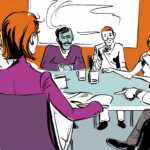“It’s not time that matters, but what we do with it.” -Bruce Lee
Measuring User Stories in working hours is a common but imperfect practice. Indeed, as the text provided indicates, it diverts attention from the main objective of estimation: to build a shared understanding of the task to be carried out between all members of the Scrum team.
Limits of the evaluation in hours
Person hours do not take into account the complexity of the task or the effort required to complete it. This limitation is particularly visible when integrating new features into existing software, where technical challenges such as version incompatibilities or complex dependencies are poorly understood.
Story Points, a better alternative
Story Points are a superior alternative to man-hour estimation. They reflect the complexity of the task and the efforts required to complete it. So, a complex User Story with many dependencies could be estimated at 8 Story Points, while a simpler User Story would be at 2 Story Points.
Towards a concentration on added value
By using Story Points instead of man hours, the team focuses on creating value for customers rather than traditional project management. This enables a more agile approach to software development, adapting to changing customer needs.
The debate around estimates in agile methods
Some question the very usefulness of estimates within agile methodologies, proposing to focus on continuous feature delivery without formal estimates (the No Estimates philosophy). However, each approach has its challenges and must be adapted to the culture of the team.
Conclusion
In short, Story Points offer a more tailored approach to estimation, taking into account the complexity and effort required to complete a task. This promotes an agile and iterative approach to software development, allowing greater flexibility to meet changing customer needs.
References
- Wake, B. (2002). Extreme Programming Explored. Addison-Wesley Professional.
- Cohn, M. (2005). Agile Estimating and Planning. Prentice Hall.











